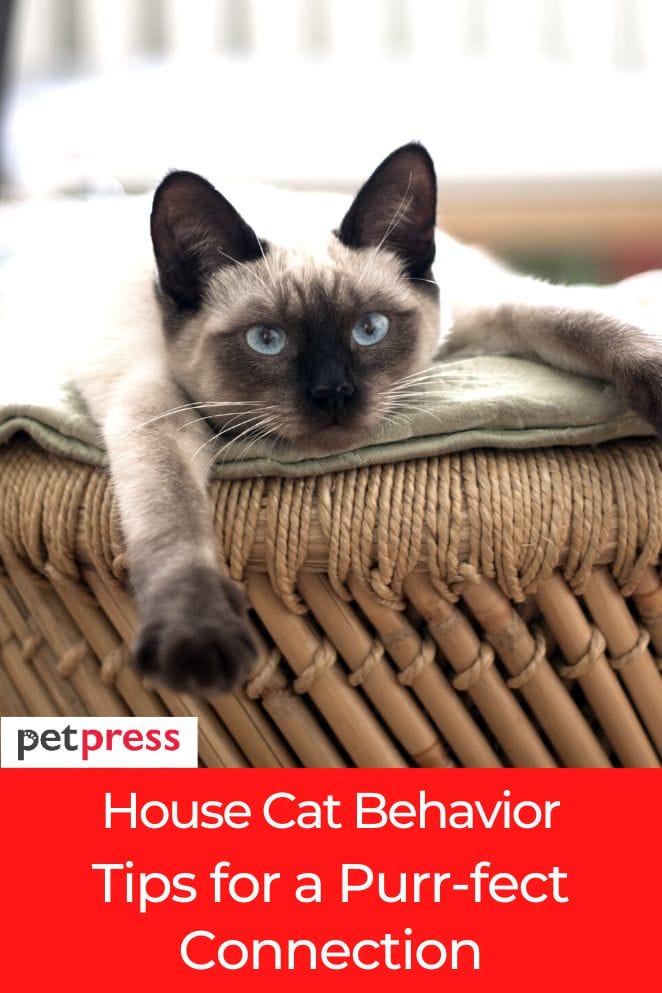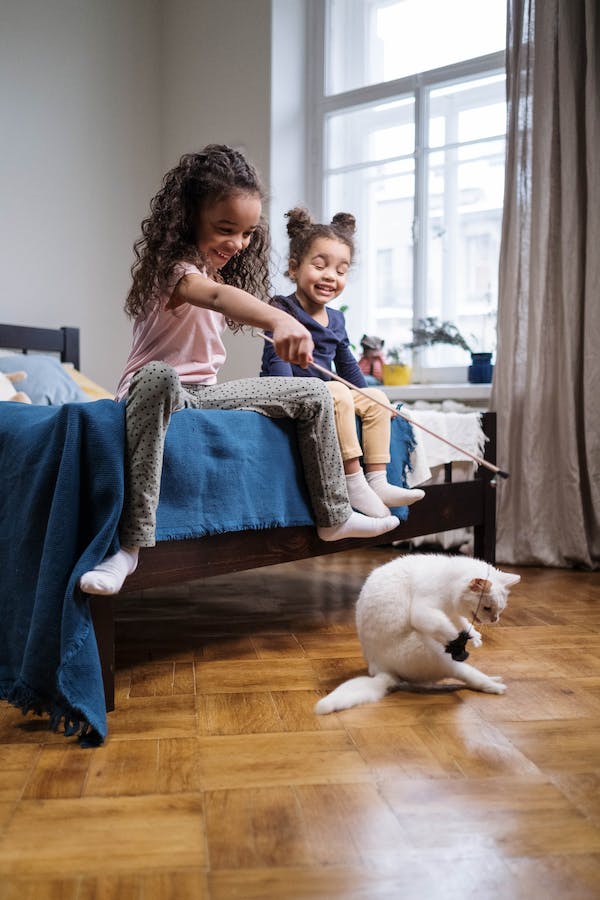
Greetings, fellow feline enthusiasts!
If you’ve stumbled upon this piece, you likely share your home with a domestic cat or are contemplating the joy of welcoming one into your life.
Cats, with their distinctive personalities and endearing quirks, are truly captivating creatures.
In this article, we embark on an exploration of the intriguing realm of house cat behavior.
Whether you’ve pondered the motivations behind your cat’s actions or seek to forge a stronger connection with your fur-clad companion, read on as we delve into this captivating subject.
Common House Cat Behaviors
Let’s delve into common house cat behaviors in more detail:
Purring
The gentle, rhythmic sound of a cat’s purring can be incredibly soothing.
Typically, cats purr when they’re content and at ease, often while enjoying a petting session or lounging in a cozy spot.
However, it’s crucial to understand that cats may also purr in circumstances where they’re experiencing pain or stress.
In such cases, purring serves as a self-soothing mechanism or a means to convey their discomfort.
Scratching
Cats have gained a reputation for their love of scratching, which might appear destructive but serves multiple essential purposes.
Scratching isn’t solely about sharpening their claws; it’s also a means of marking their territory.
Cats possess scent glands in their paws, and when they scratch, they leave their unique scent behind.
Additionally, scratching enables them to stretch and exercise their muscles, contributing to their overall physical well-being.
Hiding
Cats are experts at the game of hide and seek.
They may disappear when they feel overwhelmed, anxious, or simply in need of some alone time.
This hiding behavior is akin to their personal “me” time, a moment to recharge and escape from any potential stressors in their environment.
Respect their need for solitude and provide them with a quiet, safe space when they seek it.
Kneading
If you’ve ever felt your cat kneading you with their paws or a soft surface, it’s an endearing behavior reminiscent of kittenhood.
Kittens knead their mother’s belly to stimulate milk flow while nursing.
This behavior often continues into adulthood as a sign of comfort and contentment. It’s a way for cats to express their affection and feel secure.
Playfulness
Cats are naturally curious beings with an inherent desire to explore their surroundings.
This curiosity satisfies both their mental inquisitiveness and their physical health.
Play plays a pivotal role in a cat’s overall well-being, as it aids in exercise, sharpens their hunting instincts, and combats boredom.
Supplying them with toys and engaging in interactive play sessions is an effective approach to fulfilling their need for mental and physical stimulation.

Behavioral Challenges of House Cats
While cats are undeniably charming, they can sometimes present behavioral challenges that leave us scratching our heads.
Here are a few common issues:
Scratching furniture
Cats have a natural instinct to scratch, as we discussed earlier.
It’s a way for them to maintain their claws and mark their territory.
However, this behavior can become a challenge when they choose your cherished furniture as their scratching post.
To address this issue, it’s essential to provide appropriate scratching alternatives, such as scratching posts or pads, and place them strategically in your home.
Litter Box Problems
Problems with the litter box can be one of the most frustrating challenges cat owners face.
Cats may stop using the litter box for various reasons, including medical issues, stress, or even dislike of the type of litter.
It’s crucial to rule out any medical problems by consulting with a veterinarian if your cat’s litter box habits change suddenly.
To address behavioral issues, ensure the litter box is clean and in a quiet, accessible location.
Aggression
Cats can display aggression towards other cats or humans, and it usually stems from fear, territorial instincts, or stress.
Cats are known for their independent nature, but they can become aggressive if they feel their territory is threatened or if they perceive a potential rival.
To address aggression, you should identify the root cause.
If it’s aggression towards other cats, consider gradual introductions and providing separate resources for each cat.

Why Do Cats Exhibit These Behaviors?
Understanding the “why” behind your cat’s actions is the key to addressing these behavioral challenges. Let’s delve into the reasons behind these common cat behaviors to better understand their motivations:
Scratching furniture
Cats scratch furniture for several reasons:
- Instinct: Scratching is an innate instinct for cats. It helps them shed the outer sheath of their claws and keep them sharp for self-defense and climbing.
- Territorial marking: Cats have scent glands in their paws. By scratching, they leave both a visual and scent mark, establishing their territory.
- Stretching: Scratching also allows cats to stretch their muscles, maintaining their flexibility and overall well-being.
Litter box problems
Litter box issues can arise from various factors:
- Health problems: Cats might avoid the litter box due to urinary tract infections, digestive issues, or other medical conditions.
- Stress and anxiety: Changes in the household, such as a new pet or a move, can cause stress and lead to litter box problems.
- Litter preferences: Some cats have specific preferences for the type of litter they use.
Aggression
Aggressive behavior can stem from various sources:
- Territorial aggression: Cats can become aggressive when they feel their territory is threatened by another cat.
- Fear or stress: A cat may lash out when they feel threatened or anxious.
- Play aggression: Sometimes, overly enthusiastic play can escalate into aggression.
Tips to Build a Strong Connection with Your House Cat
Building a strong bond with your house cat is a rewarding experience. Here are some tips to help you nurture that connection:
Quality time
Spend time with your cat engaging in activities that they enjoy.
Cats are social animals, and they thrive on interaction with their human companions.
Playing with toys, using interactive laser pointers, or simply engaging in some gentle petting can go a long way in building a strong bond.
Cats have unique preferences, so take the time to discover what activities your cat enjoys the most.
Positive reinforcement
Positive reinforcement is a powerful tool in cat training.
Whenever your cat exhibits desirable behavior, be it using their scratching post instead of your furniture, using the litter box correctly, or responding to a command, reward them with treats, praise, or affection.
This helps reinforce the behavior you want to encourage and strengthens the bond between you and your cat.
Understanding their needs
Meeting your cat’s physical and emotional needs is crucial for a strong connection:
Comfortable environment
Ensure your home provides a safe, comfortable, and stimulating environment. Cats appreciate cozy spots by windows, scratching posts, and hiding places.
Balanced diet
Offer your cat a balanced and nutritious diet. Consult with your veterinarian to choose the right food for their age, size, and health condition.
Mental stimulation
Cats need mental stimulation to prevent boredom.
Puzzle toys, treat-dispensing toys, and even rotating your cat’s toys can keep their minds engaged.
Consider creating vertical spaces with cat trees or shelves for climbing and exploration.

DIY Cat Enrichment Ideas for a House Cat
Want to keep your indoor cat mentally and physically stimulated? Try these DIY cat enrichment ideas:
Puzzle feeders
Puzzle feeders are excellent tools to challenge your cat’s problem-solving abilities and make mealtime more engaging.
You can create a simple one by poking holes in a small cardboard box or using a muffin tin.
Place kibble or small treats in the compartments, and your cat will need to figure out how to get to the food by batting or pawing at the items.
Catnip toys
Catnip is like magic for many cats.
To make your homemade catnip toys, you can sew a small pouch from fabric, fill it with dried catnip, and then stitch it up.
Alternatively, you can wrap catnip in a clean, old sock and tie a knot to create a catnip-filled sock toy.
When your cat interacts with these toys, the catnip’s scent is released, resulting in playful antics and excitement.
Feather wands
Feather wands are simple yet highly effective DIY toys that mimic the movements of birds or insects, which cats love to chase.
To make one, attach a feather or a lightweight toy to a string or a stick.
You can even use a dowel rod or a flexible branch as the handle.
Wave the feather wand around, and your cat will pounce and jump, providing a fun and interactive playtime experience.
Conclusion
Developing a deeper connection with your house cat hinges on comprehending and embracing their distinctive behaviors.
Cats are multifaceted creatures, each with their own personality.
By acknowledging their needs and offering suitable avenues for their natural instincts, you can establish a peaceful and gratifying environment for both you and your cherished feline companion.
This mutual understanding and effort can lead to a more harmonious coexistence with your pet.
FAQs
Cats scratch to mark their territory, exercise, and maintain their claws. Providing a scratching post can help redirect this behavior.
Understand the root cause of the aggression, which could be fear, territorial issues, or an underlying medical problem. Consult with a veterinarian or a professional cat behaviorist for guidance.
Gradual introductions, using scent swapping and separate living spaces, can help ease the transition. Patience is key to ensuring a smooth and peaceful coexistence.


GIPHY App Key not set. Please check settings